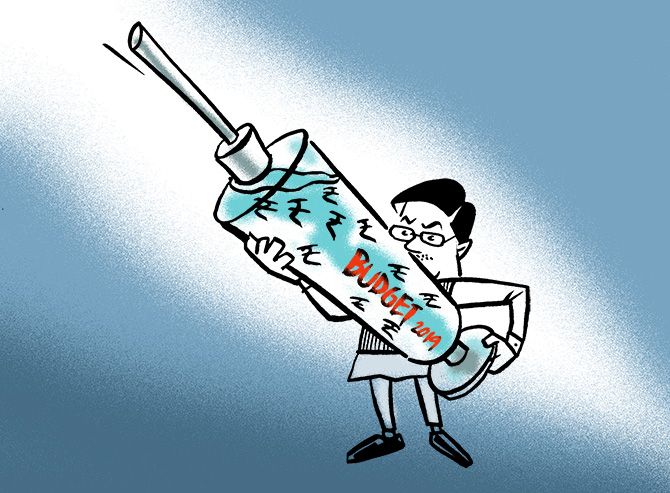The negative aspect about the Budget is that the capital expenditure has been marginally cut to achieve the fiscal deficit target assumptions, and the onus of sustaining investment demand till private capex revives continues to vest with the public sector enterprises, notes Jyotivardhan Jaipuria.
Illustration: Dominic Xavier/Rediff.com

The challenge in any election year Budget before every finance minister is how to give sops to the electorate without straining the fiscal deficit.
In that light, the finance minister has been able to balance populism with pragmatism.
Let's first look at the key constituents the finance minister has given sops to followed by whether he has achieved the fiscal consolidation objective.
The first constituent the Budget addressed was the rural poor, given the distress in the agriculture sector.
With the buzz of a Universal Basic Income (UBI) scheme being loud before the Budget, the actual amount of Rs 75,000 crore is in some sense lower than what was generally expected.
The Prime Minister Kisan Samman Nidhi (PM-Kisaan), aims at benefitting 120 million poor farmer families and seeks to provide Rs 6,000 per year to farmers with less than 2 hectares of cultivable land.
With a focus on the poor, unorganised labourers, the Budget has launched a pension scheme which is a laudable beginning to providing a social security net.
The second constituent that the Budget addressed was the middle class through a tax rebate scheme for those who earn up to Rs 5 lakh annually.
This will help save tax of Rs 18,500 crore for around 30 million tax-payers.
Another Rs 4,700 crore tax-saving comes to the salaried class through an increase in standard deduction.
The above measures together constitute a Rs 1-trillion fiscal stimulus.
The third constituent that the Budget addressed was the real estate sector, which has been seeing a lot of strain over the past few years.
There were four specific measures to help the sector.
Of these, two measures were aimed at increasing housing demand by giving tax concessions for owning a second house.
The other measures were aimed at improving the profitability of the real estate company through tax breaks.
While providing these subsidy measures and tax concessions, how much has fiscal consolidation suffered? Thankfully, the answer is not much, with the fiscal deficit target of 3.4 per cent for FY19 being a marginal miss over the Budget Estimates.
The forecasts for FY20 of 3.4 per cent are not out of whack, though, of course, the glide path towards 3 per cent keeps getting extended.
The good news is that we have managed to reduce the fiscal deficit to 3.4 per cent from 4.4 per cent five years ago.
Critics may argue that this is led by an oil bonanza with a drastic fall in oil prices globally and taking loans off the balance sheet, especially of Food Corporation of India.
But from a government point of view, this is balanced by the fact that a big reform like GST was in an implementation phase.
The other question that arises in every Budget is the credibility of the assumptions in terms of revenue and expenditure and hence the probability of slippage in the fiscal deficit targets.
First, if we look at the tax revenue, there is an assumption of around 13.5 per cent increase in tax revenues, which may not be very aggressive if the assumed 11.5 per cent nominal GDP growth is achieved.
Within the tax break-up, it is possible that the GST revenues lag (especially if the rates are cut further), but are made up by stronger than estimated direct tax collections.
The worry could be more on the disinvestment target of Rs 90,000 crore that is aggressive and may force the government to resort to passing on the burden to other public sector undertakings.
The second reason of concern is the ask on dividend from banks, where the burden may fall on the RBI.
But overall, we are not too concerned on the revenue side.
It is on the expenditure side that the government needs to keep a tight leash on all expenditure other than the UBI scheme.
The negative aspect is that the capital expenditure has been marginally cut to achieve the fiscal deficit target assumptions.
In terms of implications, first on the bond market.
The concern is on the larger than expected size of gross borrowings at Rs 7.04 trillion.
While the net borrowings at Rs 4.48 trillion is in line with estimates, a much greater reliance has been placed on the National Small Savings Schemes and draw-down of cash balances, which poses a risk.
Secondly, the other risk factor is that the OMO by the RBI may not be as high as in FY19.
These risks are balanced by likely low inflation that will likely help keep bond yields stable.
The second is the implication on growth.
The Budget helps consumption over investment with a fiscal stimulus of around Rs 1 trillion to the section of population whose propensity to consume is very high.
The onus of sustaining investment demand till private capex revives continues to vest with the public sector enterprises (PSUs).
The PSUs have led the investment thrust over the past five years, too, with their borrowings having doubled as they embark on capex plans.
Also, the measures for the real estate sector could help improve demand that provides relief to not just the sector but also the banking and NBFC space where real estate is one area of stress.
Finally, from the equity markets point of view, we think the importance of Budgets have waned considerably and this Budget is no different.
The equity markets are not cheap at nearly 18x one-year forward earnings.
Hence, the long awaited acceleration in earnings is the key to driving markets.
We think FY20 will be a year of strong earnings growth that will provide support to markets.
The other key positive for the markets has been the dovish Fed that could help trigger a move from developed markets to emerging markets.
Jyotivardhan Jaipuria is founder and managing director, Valentis Advisors.











